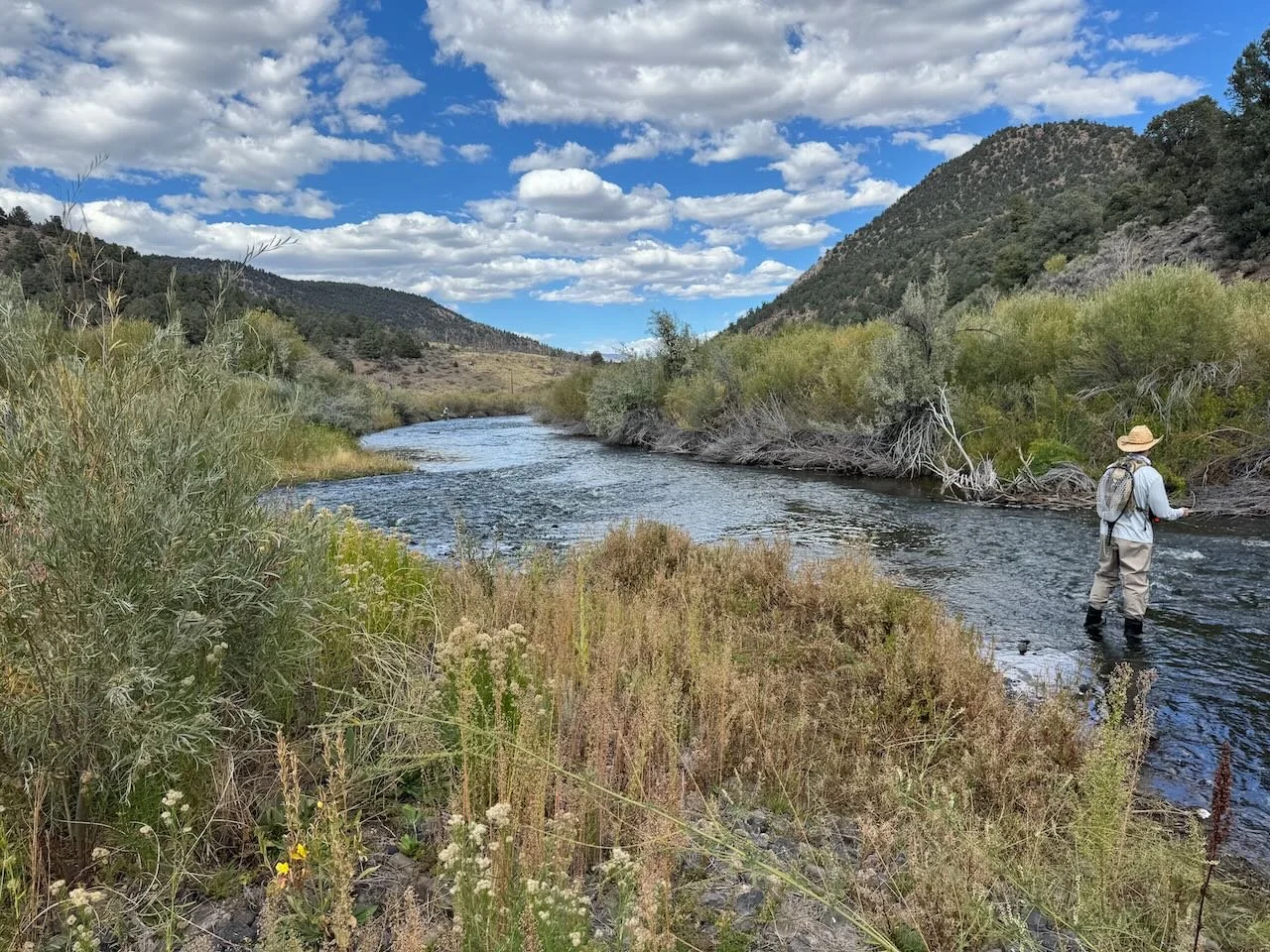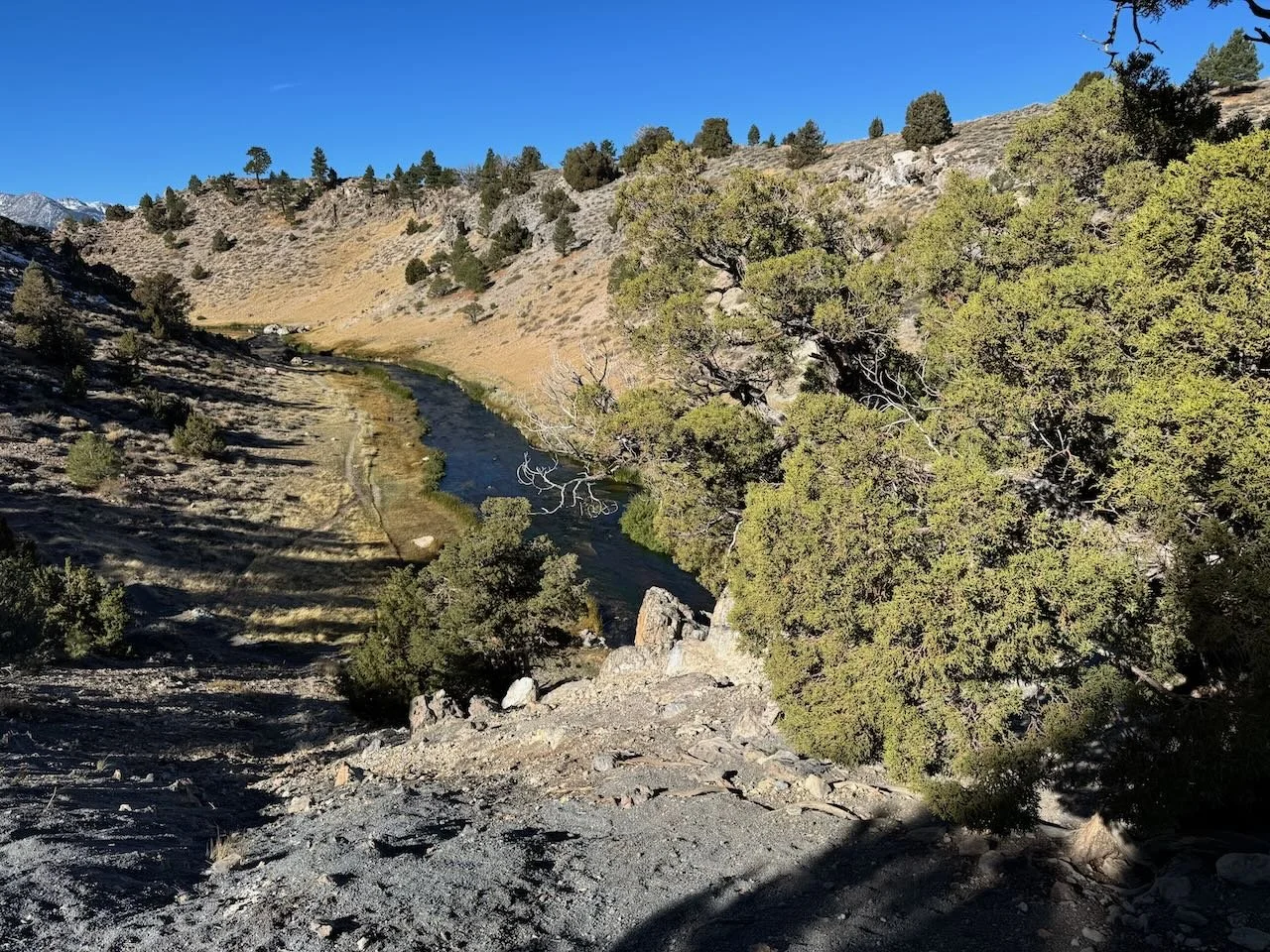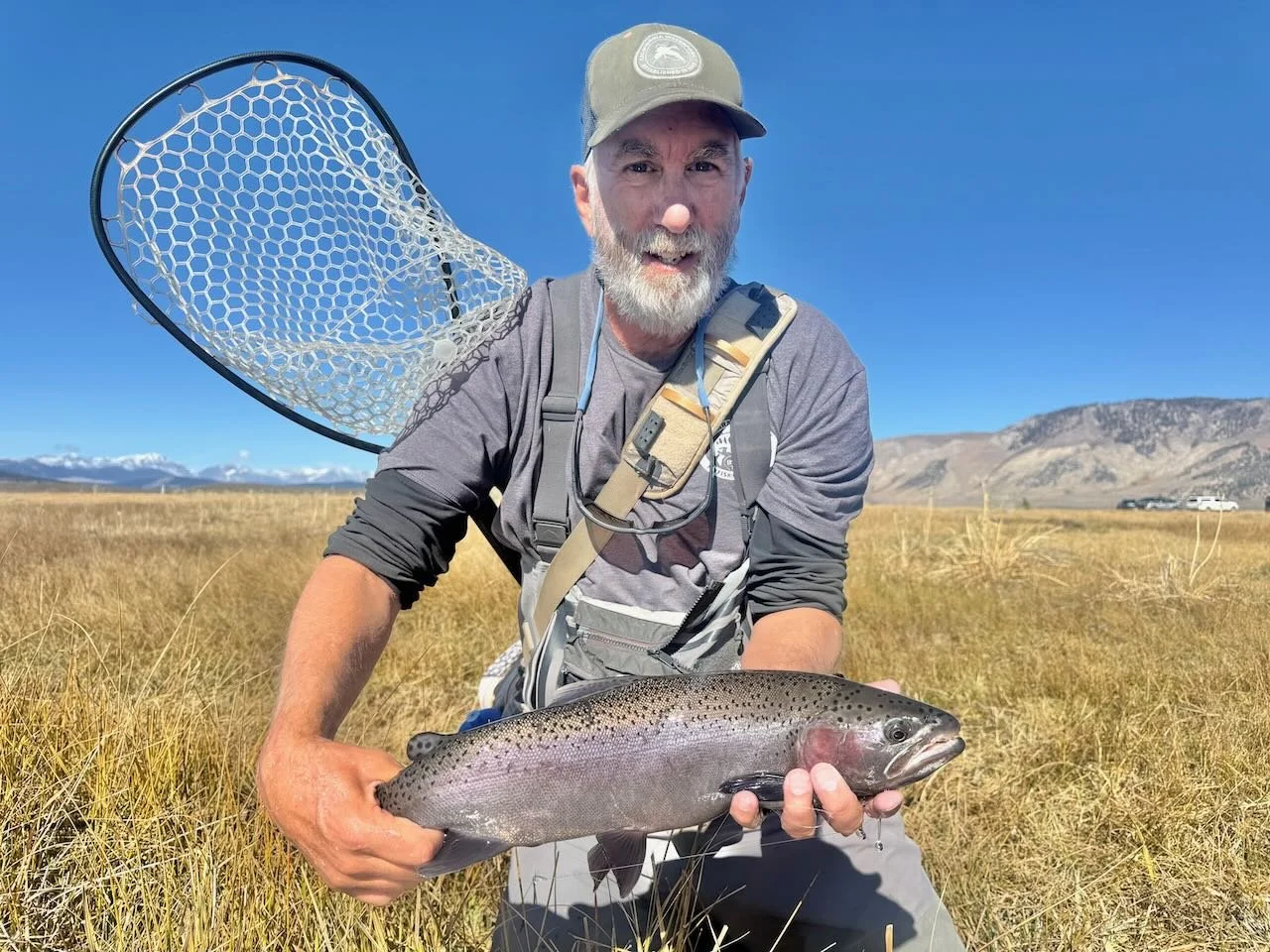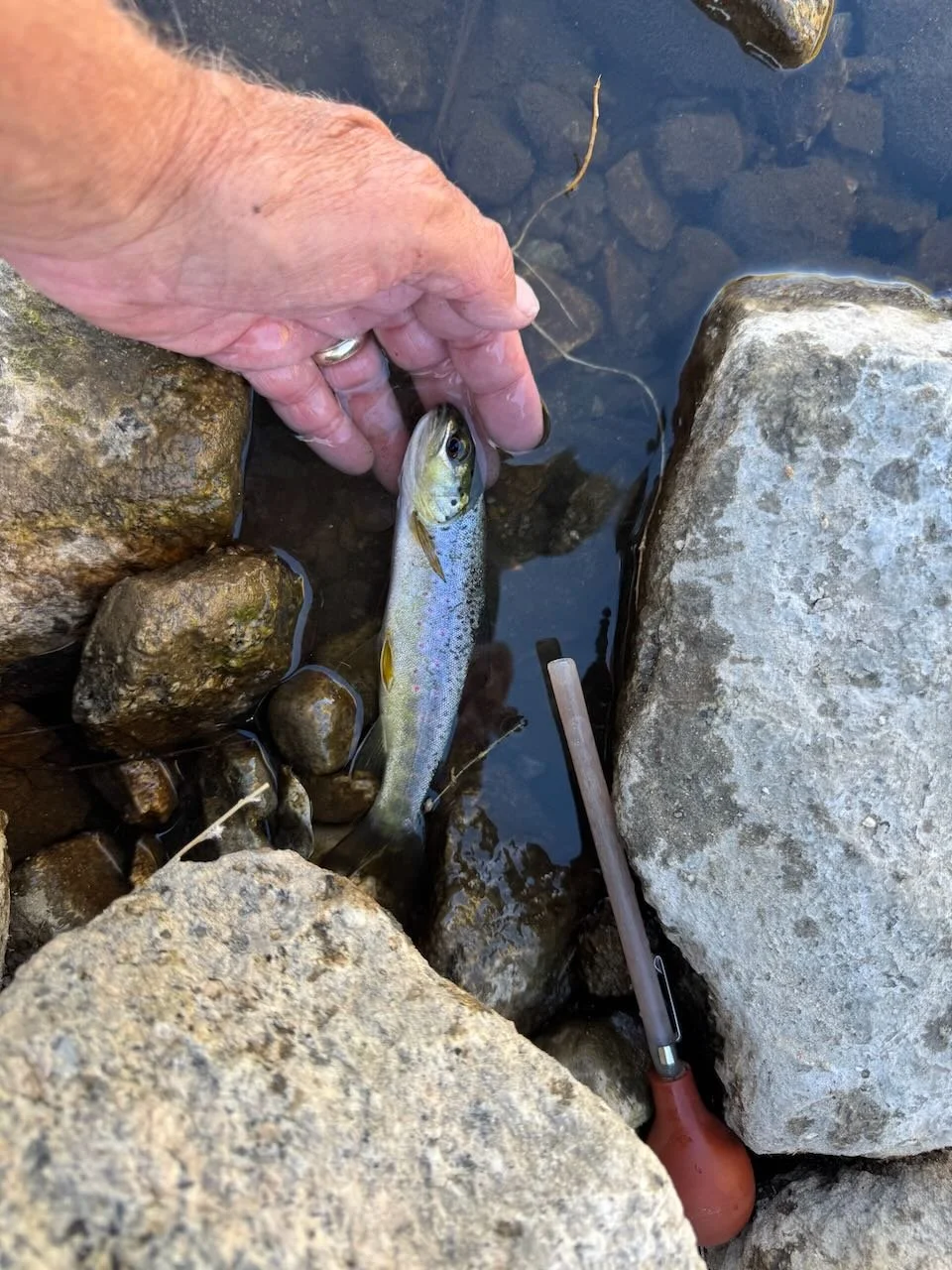Perfect fall weather will be welcoming fly fishers to the Eastern Sierra over the next week or so. Warm days, no wind, rising fish and trophy trout make it a perfect time to come fly fish the Eastern Sierra. It will not be long before upper elevation waters will be covered with snow. So now is the time to fly fish high country lakes and streams for spawning brown and brook trout. Trophy trout are migrating out of the lakes into the streams to spawn. Hatches of mayflies, midges and caddisflies are feeding trout on the substrate and on the surface.
Fall in the Eastern Sierra is the time to be looking for trophy trout like this rainbow trout from the upper Owens River.
East Walker River:
Flows are back up to 60 CFS which is low, but fishable. Season ends in two weeks on November 15th.
Fly fishers have two weeks to explore the fly fishing opportunities of the East Walker River before it closes on November 15, 2025.
Lower Owens River
Wild Trout Section:
Fly fishers looking for a quantity fishery will find the lower Owens River will produce good numbers of wild brown and rainbow trout nymphing. Wading upstream and casting to the riffles so your nymphs drop into the holes is where you will find the trout taking your nymphs. The key to success is having the right amount of weight in the flies or on the tippet so the flies are slowly flowing over the substrate where the trout are feeding on nymphs. For an indicator rig use a size one split shot 12 to 18 inches above the fly and the indicator six feet above the fly. Indicators go 1.5 to 2 times the average depth of water above the fly. For nymphs fish with size 18 olive quilldigons, size 18 bead head flash back pheasant tail nymphs, size 18 SOS nymphs and size 18 midges in tiger and zebra coloration. A size 20 blue wing olive parachute, size 20 Adams parachute and size 20 sparkle dun will produce a few trout on the surface mid-day.
New fly fisher Luca Burns with a nice lower Owens River rainbow that took a size 18 bead head flash back pheasant tail nymph under an indicator.
Hot Creek
Interpretive Site:
The Interpretive Site is the place to fly fish with dry flies in the morning. Look for the trico hatch in the morning followed by a blue wing olive hatch and a caddis hatch. Start the morning with a size 22 trico female parachute. Then switch to a size 20 blue wing olive parachute. Finish the morning session with a size 20 gray elk hair caddis. Fish the dry flies on a nine foot 5X leader and three feet of 6X tippet. When the hatch is over it’s time to find a new water to fly fish like head over to the upper Owens River.
Hot Creek Canyon is offering nymphing and dry fly fishing opportunities in the mornings.
Hot Creek
Canyon Section:
The weed beds are slowly starting to break up. Before and after the hatch try nymphing in the lanes between the weed beds and in the holes. Use size 18 olive quilldigons, size 18 bead head flash back pheasant tail nymphs, size 18 olive quill RS2 and size 18 tiger and zebra midges to fool the wild rainbows and brown trout feeding on the substrate. In the morning there are hatches of mayflies and caddis. Fish with size 20 blue wing olive parachutes, size 20 gray elk hair caddis and size 22 female trico parachutes on the surface to fool the trout taking dries.
A rare photo of Fred Rowe catching trophy rainbow trout on the upper Owens River. Photo by Brian Chastain
Upper Owens River
Above Benton Crossing Bridge:
This is the time of year when trophy brown and rainbow trout from Crowley Lake migrate up the Owens River. The fish are in the river and taking nymphs and streamers. Nymph with size 12 stoner nymphs, size 12 green/gold Prince nymphs, size 12 gold ribbed hare’s ear variations, size 14 copper John’s and size 16 hot spot pheasant tail nymphs in the deep holes, deep runs and cut banks. For streamers use size 6 or 10 matukas, wooly buggers, slumpbusters and marabou muddlers stripped upstream in the deep holes, deep runs and cut banks where the trophy trout are resting and feeding. When streamer fishing fish downstream and strip upstream and cover lots of water looking for those few trout wanting to feed on your streamer. There is a morning mayfly hatch and mid-day caddis hatch that resident six to 12 inch trout are feeding on. In the morning fish with size 20 trico female parachutes, size 20 Adams Parachutes, size 20 blue wing olive parachutes and size 20 blue wing olive sparkle duns. Mid-day fish with size 18 or 20 elk hair caddis. There is very little water left from the storm two weeks ago on the dirt roads.
Figuring out what the trout were feeding on and putting on a size 20 blue wing olive parachute produced several juvenile rainbows and browns on Bishop Creek Canal.
Bishop Creek Canal
Behind Bishop Veterinary Hospital:
This time of the year is perfect to be on the waters of the Owens Valley. Bishop Creek Canal is a perfect water to fish mid-day during the fall. Mornings fish with nymphs like size 18 olive quilldigons, size 18 bead head flash back pheasant tail nymphs, size 16 hot spot pheasant tail nymphs, size 18 Frenchies, size 18 green/gold brassies and size 16 midges in tiger and zebra coloration. Mid-day there is a midge and mayfly hatch bringing juvenile rainbows and brown trout to the surface. Fish with size 18 blue wing olive parachutes, size 18 Adams parachutes, size 20 Griffith’s gnat and size 20 olive midge adults.






